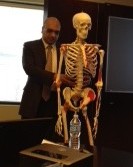
[caption id="attachment_1119" align="alignleft" width="238" caption="A representative of Tornado Medical Systems demonstrates the benefits of the companys MRI products"] [/caption]
[/caption]
So far I’ve chronicled my visit to Canada by focusing on what I’ve learned so far about the country’s focused efforts on growing its medical device industry – which is, of course, the primary purpose of the Advanced Medical Devices Media Tour, organized by the Ontario Ministry of Economic Development and Innovation (MEDI).
But in addition to learning about the many incentives Ontario provides med tech companies to set up shop in the province, I’ve also had the rare opportunity to interact with other journalists from all over the globe. I am certain that my overall experience here in Canada has been enriched by the diversity of the group I am touring with.
After two days of meeting with the CEOs of Toronto-based medical device companies, our group is now in Thunder Bay, Ontario where we will tour a local research institution and more medical device companies.
My travel companions include journalists from France, Germany, India, Japan, China, and London, in addition to our Canadian representatives from MEDI. I am actually the only U.S.-based journalist in the group. Here in Thunder Bay there are 18 of us all together, including the two MEDI representatives and one MEDI photographer. Last night at dinner I joked that because of our widely diverse backgrounds, the 18 of us in the group could probably rule our own country if we had to. One of the MEDI reps quipped back that we could call ourselves the G18 – a nickname I liked so well I borrowed for the title of this blog post.
But on a more serious note, it has been a highly educational experience to not only learn about the Canadian medical device industry but also to engage in conversations with my fellow journalists about what healthcare is like in their country and what challenges their medical device companies face. Although I was already aware of some of these issues – like how long Japanese patients have to wait for new technology because of the rather slow time to market in their country – hearing about the problem from the perspective of a Japanese reporter somehow had more impact for me than just reading about it.
